| 1 | Common lancehead |
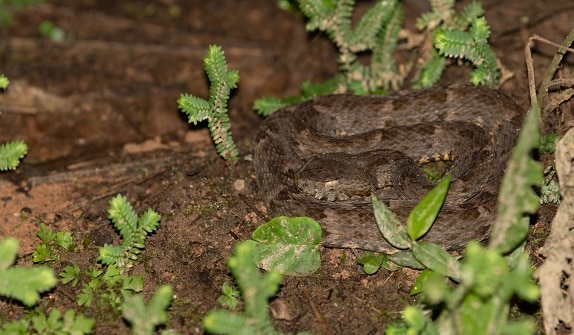
Location: most of South America.
The most common Bothrops pitviper in the world also has some of the niftiest camouflage. Common lanceheads don’t have especially flashy patterns, but this is their stroke of genius, as it allows them to blend in with endless forest environments. They can become near invisible on rotting logs, soil-covered earth, and piles of leaf litter alike.
Common lanceheads have a tendency to invade coffee and banana plantations, and lurk there waiting for rodents. Workers can harvest coffee beans all morning, standing metres away from a disguised common lancehead for hours. When threatened, their response varies. Common lanceheads can flee, shake their tail loudly against leaf litter, or attack without warning.
Symptoms include necrotic skin, haemorrhaging, and death by kidney failure. They can release 342mg of venom in one bite, and cause 50% of all snakebite deaths in some Amazonian regions. Before the dawn of antivenom, a bite was a virtual death sentence, but these days they’re easily treated – as long as you reach the hospital in time.
| 2 | Burmese python |
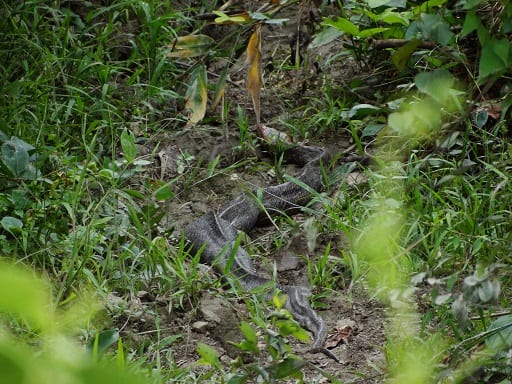
Location: Burma, Bangladesh, Florida (invasive).
The Burmese python is an ambush predator, most of which have strong camouflage, but this species has gone particularly far down the unnoticeable path. Burmese pythons have a golden-beige base of colours, but with huge brown blotches with black outlines. At 5 metres, often 7 metres, they’re one of the longest snakes in the world, which makes it all the more impressive how they can vanish without a trace.
Burmese pythons can be extremely hard to notice in forested undergrowth, and above all marshland. In the 1990s, they became an invasive species in the Florida everglades, with determined efforts to wipe them out ever since. These have completely failed, and their amazing camouflage is one reason why. The population in Florida is now over 100,000, and it’s estimated that for every Burmese python spotted by a passerby, another 1000 go unnoticed.
This was exemplified in 2013, when a month-long hunt was announced, open to all members of the US public, with financial rewards offered, only for the final tally to be 68. Burmese pythons undergo no colour change, being the same beige-black shade from birth till death.
| 3 | Timber rattlesnake |
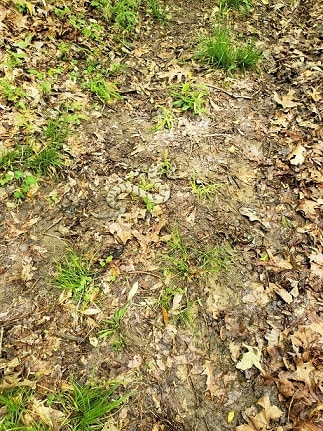
Location: eastern USA.
This is one of the rattlesnakes most commonly encountered by normal Americans, made worse by their ability to blend into leaf litter and completely disappear. Timber rattlesnakes are a northerly species, plentiful in Ohio and Pennsylvania, and hang out in cool forests where whistling dog walkers stretch their legs every day.
Dozens of people each year stop to admire the forest, only to jump back in fright when they spot a timber rattlesnake right next to their boot. They’re visible while on the move, but while resting in ambush, as they love to do, it’s very hard to spot them.
Timber rattlesnakes are mainly docile and not itching to strike, but have killed 15-20 Americans since the turn of the century. They can reach lengths of 150cm and the record was 189.2cm. The best solution is simply to stick to paths and tread carefully when wading through fallen leaves. Take your headphones off when strolling through the forest and keep an ear out for the signature warning rattle – they might be audible even if they’re invisible. If you’re lucky, the timber rattlesnake will be resting inside a fallen log instead, one of its favourite haunts. Like other rattlesnakes, they can strike from distances two thirds of their body length.
| 4 | Rainforest hognosed pitviper |
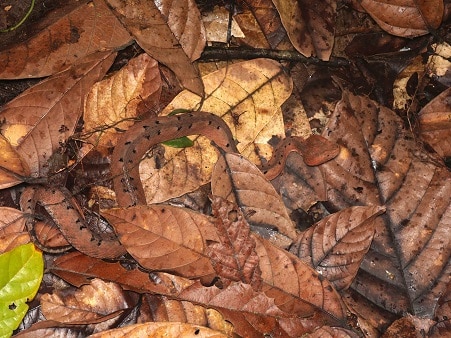
Location: Central America, Colombia, Ecuador.
Rainforest hognosed pitvipers not only blend into forests, but match the exact shade of leaves of the rainforests they inhabit, down to the pigment level. Their colour varies, with some being orange to match fallen leaves, and others muddy brown to match the miscellaneous mulch. The best chance of spotting this bitey snake is its via incredibly triangular head.
Rainforest hognose pitvipers have a wide range in central America, being most heavily concentrated in Costa Rica. You’re safe from this disguised snake in open ground, as they’re an almost exclusive forest dweller. Their favourite spots of all are the thick bases of trees, but never let your guard down. It’s rare for rainforest hognose vipers to kill, with a weak LD50 rating of 4.6mg. But their bites can cause agonising local symptoms such as swelling and permanent stiffness surrounding the bite site.
The antivenom picture is hopeful, as while there’s no specific remedy for this species, its swelling was reversed by the CroFab antivenom used for US rattlesnakes, showing that the families have crossovers in toxins.
| 5 | Asian vine snake |
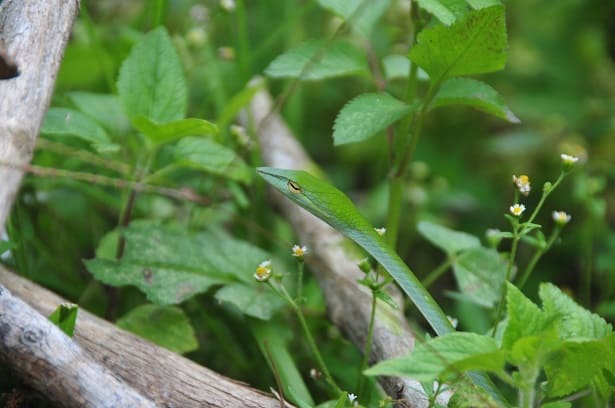
Locations: southeast Asia.
One of the most bizarre snakes on Earth, with a pointed snout and keyhole shaped pupils. Asian vine snakes (Ahaetulla prasina) feed on lizards, and all their survival attempts have been funnelled into camouflage, more specifically an attempt to look like swinging jungle vegetation. Asian vine snakes match the precise shade of green as the forests they inhabit, and by dangling from a tree branch with their strong tail, swaying slightly in the wind, they precisely mimic the vines they are named after.
What happens if you fall for its deception? There’s a cackle of laughter and a blindingly fast lunge of fangs – or more accurately, the Asian vine snake will probably flee into the bushes, as it gets spooked quickly when its disguise is foiled. However, it has turned out to secrete a very mild venom from its rear fangs, which is unlikely to harm a human.
A 2018 study found that this venom consists of metalloproteineases, with a similar profile to viper venom. Metalloproteinases physically break through skin cells, cleaving through amino acids, replicating natural skin recycling, but to destructive levels. The result in a more powerful snake would be necrosis.
| 6 | Sahyadri Hills whipsnake |
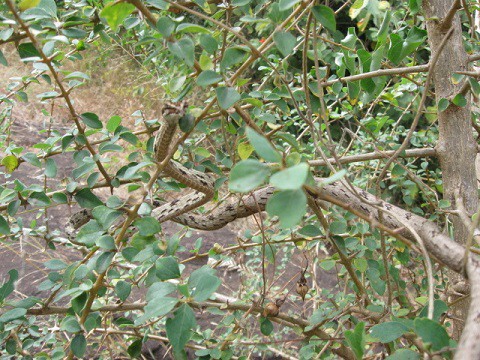
Location: central western India.
The Sahyadri Hills whipsnake (Ahaetulla sahyadrensis) is the browner, more parched relative of the Asian vine snake. At the dawn of time, the two apparently reached a deal – the Asian vine snake would resemble swinging greenery, while Ahaetulla sahyadrensis would disguise itself as a thin branch. You can see that it’s a living breathing snake when staring it in the face, but walk past, chattering to your explorer friends obliviously, and there’s little chance you’d notice them out of the corner of your eye.
Ahaetulla sahyadrensis lives in the western Ghats mountain range of India, sticking to deciduous forests on the outskirts of perennial streams. They might be even more bizarre than the Asian vine snake, as their pointy mouths curl upwards at the end, looking like a fleshy hook. Their pupils are even more warped, while their scales seem to have stolen the bark of a tree.
Very little is known about this snake’s lifestyle or diet. All we know is what’s clearly ascertainable from pictures, that their survival strategy is extreme camouflage. Ahaetulla sahyadrensis were once regarded as the same species as brown vine snakes from Sri Lanka, another Ahaetulla family member.
| 7 | Smooth green snake |
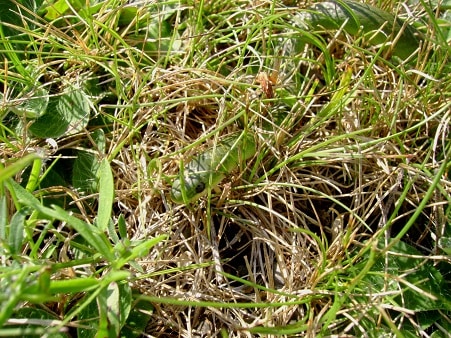
Location: USA.
This non-venomous snake is a master at disappearing in rural spots of New York or Pennsylvania. Smooth green snakes are easy to spot when slithering across a road, but the moment they enter their grassy comfort zone, all hope vanishes. This snake is one of the hardest for scientists to survey, despite living in densely populated northeastern US states.
Smooth green snakes have subtle colour variations across the USA, but always with green predominating. They have slight blue tinges in Kansas, olive tinges in Texas, and bronze tinges in Wisconsin. They have a strongly olive tint as newborns, but once their first skin shed is complete, they blossom into the brightly green camouflage masters of adulthood. The only non-green section of their body is the tongue, which is red with a black forked tip.
Smooth green snakes mostly stick to the ground, but also climb into low bushes, which they’re equally successful at blending into. They even bob their heads in order to mimic vegetation blowing in the wind.
| 8 | Dumeril’s boa |
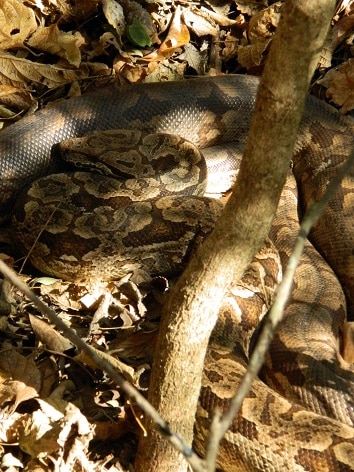
One of four boas on Madagascar, the second being the Madagascan ground boa. Dumeril’s boa reaches 2 metres long, and is common in captivity worldwide, with export restrictions being imposed recently, but breeding still happening overseas with the previous exports. Their diet includes mammals such as bamboo lemurs, and their habitats include marshes and swampy areas within forests. These have the complex vegetation where they can employ their number one skill: camouflage.
Dumeril’s boa is a beige-black snake with circular blotches, interlocking to create a constant chain of bendiness. On a grassy field they’d be exposed instantly, but the forest floor is another story. Their ambushing nature allows them to stay still, totally blending in. Collectors hoping to snatch one from the wild would come back annoyed and emptyhanded.
Some Madagascan villagers believe that their ancestors’ spirits are captured in the Dumeril boa’s circular patterns, and refuse to harm them, while others kill them on sight. Dumeril’s boas stick to the ground, as they’re very poor climbers. In a study against boa constrictors and gaboon vipers, their belly scales produced the smallest friction by far, preventing them from digging into trunks.
| 9 | Prairie rattlesnake |
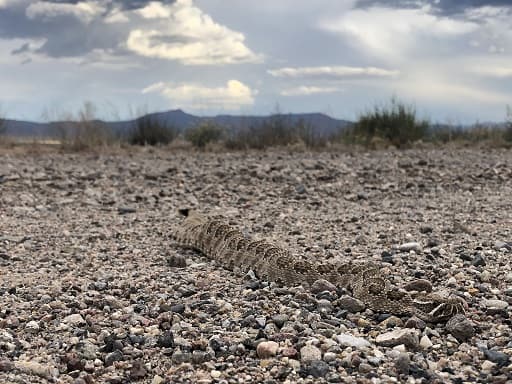
Location: the American midwest.
Rather than desert or greenery, the prairie rattlesnake is engineered towards disguising itself in sweeping prairies. These realms of rolling hills and swaying dry grass can host colonies of hundreds at once, as this is one of the most social rattlesnake species. Their base scales are pale beige, for hiding in the grass or blending into sandier areas. Overlaid on top are faded brown blotches, to mimic darker pebbles strewn around.
Without this immense camouflage, it’s unlikely that prairie rattlesnake would be as common as they are, stretching from southern Canada, all the way to northern Mexico. This is one of the paler rattlesnakes overall, similar in tone to the tiger rattlesnake of the Sonoran desert (also with excellent camouflage).
Prairie rattlesnakes need all the help they can get, as they’re often hunted by roadrunners in dry canyons, mountain lions, and cunning red-tailed hawks. This is a medium-sized rattlesnake, averaging at 100cm long. Their venom is also moderate, but more than capable of killing, relying heavily on muscle-assaulting myotoxins, with a side dose of haemorrhaging.
| 10 | Gaboon adder |
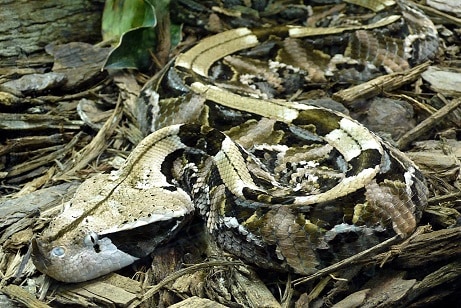
Location: sub-Saharan Africa.
The gaboon adder is an African snake famous for having the longest fangs of any venomous species, measuring 5cm. But their camouflage is another incredible feature. Gaboon adders have the typical colours of vipers – beige, brown, with lighter patches – but take the stealth game much further. The shape of the blotches closely resembles overlapping leaves, while the varying shades mimic the normal mixture of fresh foliage versus old, dried out stuff. This is nature’s finest work in forest floor camouflage, the greatest leaf-blending snake yet invented.
Gaboon adders don’t stick to forests exclusively, preferring mixtures of forests and grasslands. They’re common threats to workers, particularly in cashew, tea, and coffee plantations in Uganda. Gaboon adders are most closely related to puff adders, another venomous ambush snake, but have walked further down the camouflage path.
Thankfully, they have a calm personality, rarely striking a human unless severely provoked. Gaboon adders derive roughly 80% of their calories from mammals, with birds making up 20%. They use their camouflage to wait patiently for hours at a time.
